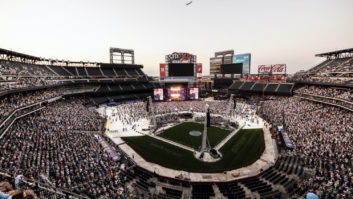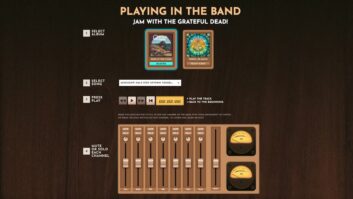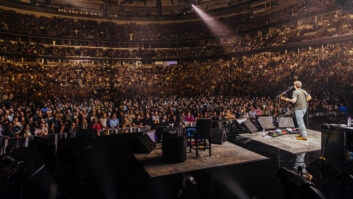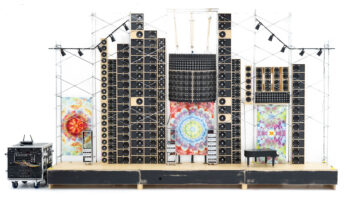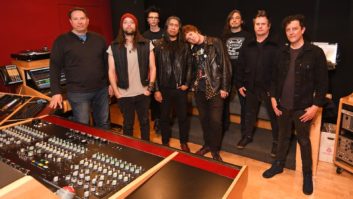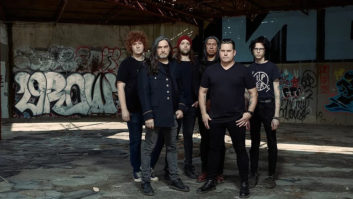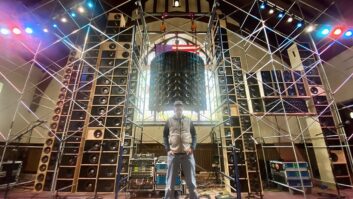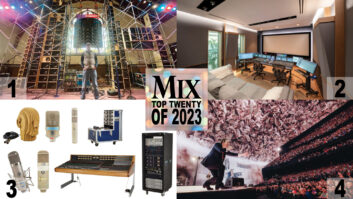NEW YORK, NY—The crew from The Grateful Dead captured a series of 22 shows in the spring of 1972. While the band did release a three-record vinyl set of the event back in ’72, only now, with the help of a talented team of audio specialists, was the entire collection re-released in a special 73- CD collection Europe ’72, The Complete Recordings.

“This project was produced by David Lemiuex (who is also The Grateful Dead archivist) and involved the entire Europe 72 tour from the spring of ’72,” noted the project’s mastering engineer, Dave Glasser of Airshow Mastering in Boulder, CO. “They had recorded 22 shows over a several-month period with a 16-track 2-inch on a modified Ampex MM-1000 tape machine. Their crew tore it apart and rebuilt it into the chassis of an Ampex VR 1000 2-inch video deck.” That allowed the use of 14-inch reels of Scotch 207 for an hour and a half of recording per reel at 15 ips. When pressed by the 90-minute limit, Glasser revealed, “They had a 2-track mix going in a truck, and on some occasions, they turned to those tapes to bridge the reel changes. In other cases, there were some edits that could make the songs work.”
An important part of this project was the transfers and Plangent Processes speed correction, handled by Jamie Howarth. “We first camped out at Sonicraft A2DX Lab in NJ, where after transferring the first 10 reels, they did the other 70, as there were 83 of them in total,” said Howarth. “Then we took the hard drive back to my place to finish the processing. There were 16 tracks of 96 kHz/24-bit .wav files, but 17 tracks total. From track 9, in the middle of the reel, we derived the bias, which was 152 kHz coming off the original tape. That 17th track was made into a control track .wav file.”
“Part of what we did is digitally correct the day-to-day tape speed of the original machine from one end of the reel to the other,” said Howarth. “You might start at A440 at the beginning of the show and by the end of the reel, you might be down to 434 or 435, which is substantial. You could actually start to feel the energy change.
Howarth’s process “is unique because it’s a non-real-time, oversampled pitch shift, which is incredibly transparent. But in order to do that, you have to up-sample from 96 kHz to 32 MHz. …The process runs as a batch file, four tracks at a time. It’s quite slow, as it’s not in real time, so an hour-long reel takes about eight hours to render. …Once you’re able to remove all the speed variations, as well as distortion and drift from the audio, it really hits you starkly. It’s quite dramatic and very immediate. It really helps clean up the tapes.”
The finished files were then shipped to Robert Gateley, who assembled the mixes for Jeffrey Norman. “I had to do at least five songs a day on this project,” said Norman, who mixed at Prairie Sun Recording in Sonoma County, CA. “I worked in Pro Tools|HD at 96 kHz/24-bit, coming out analog through a Neve Custom 80 Series console for the mix and then back to Pro Tools.”
“The different venues they recorded in gave another slant to the mixes,” continued Norman. “Outdoors at Lille was quite dry compared to the lush Concertgebouw in Amsterdam. On the other hand, the fact that they had to travel light and use the same equipment throughout the tour aided continuity from show to show. I used a Quantec QRS for instrument and vocal reverb. …I also used my Fairman TMC mastering compressor as the final stage compressor on the lead vocal for each tune, as well as for bass compression. Prairie Sun Studios also upgraded the automation on the Neve to Flying Faders II for the project, and that really was a terrific tool.”
At Airshow, “The audio arrived to me as 96 kHz/24-bit mixes on thumb drives,” Glasser said. “I established a signal path that was used for the whole process—Sonic Studio sound- Blade workstation, Pacific Microsonics Model Two converter, the Pultec EQM-1A3 (mastering version), Fairman TMC compressor and ZQ6 digital EQ. Occasionally I turned to an API 1500 or Maselec MEA-2 equalizer. Overall, it was very straightforward and basic. Refs were sent out weekly to David Lemieux and Jeffrey Norman. …we were all on the same page once we established a sound early in the process.”
“I would always work at high resolution,” said Glasser. “So if they ever decide to do anything with it, we’ll have the 96 kHz/24-bit mastered versions. …When the original 3-LP set came out, it was a momentous occasion. Many people feel that it’s one of the best Grateful Dead albums out there. The box set sounds different, because the approach was to create a more organic live feel than the vinyl. Overall, it was a real simple recording setup that just sounds great.”
Plangent Processes
plangentprocesses.com
Prairie Sun Recording Studios
prairiesun.com
Airshow Mastering
airshowmastering.com
